Welcome to Mattie's Gun Shop
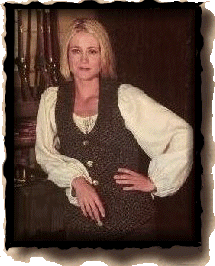
|
We supply the bullets
|

|
We supply the bullets
|
Markham, George. Guns of the Wild West: Firearms of the American Frontier 1849-1917. London: Arms and Armour Press, 1991. (160 pages)
Newton, Michael. Armed and Dangerous: A Writer's Guide to Weapons. Cincinnati: Writer's Digest Books, 1990. (pp. 22-37)
I wish to thank everyone for their help. I am, by no means, an expert on the "Wild West" firearms, so if you see an inaccuracy, or if you would just like to make a comment, please e-mail me.
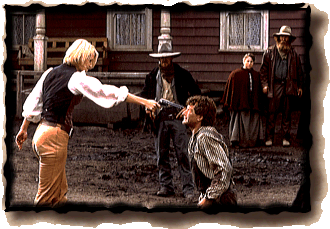
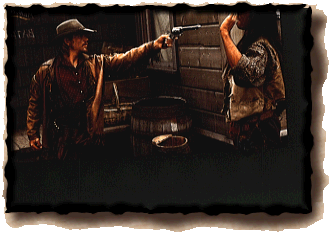
|

|
| Call aims an 1873 Peacemaker. | Austin displays a long-barreled Colt Peacemaker. |
By far, the most popular weapon featured on Lonesome Dove is the Colt Peacemaker.
Model 1851 was known as the .36 Navy Colt or the Old Model Belt Pistol. This single-action revolver was 13 inches overall, with a 7 1/2 in. barrel. It weighed 2 1/2 lbs. The cylinder periphery featured the scene of the Battle of Campeche, an little known skirvish where Texans beat the Mexicans on May 16, 1843. It was used during the American Civil War, and it was favored for balance.
The commercial double-action Colts were produced from 1877 to 1909. The .38 calibre model was named "Lightening," while the .41 and .45 were dubbed "Thunderer" and "Omnipotent," respectively. "Lightenings" had barrels 1 1/2 to 10 inches long. There were no ejectors on barrels shorter than 4 1/2 inches. "Omnipotents" accepted a wide variety of cartridges. The standard, "Omnipotent" was blued with walnut grips. The barrels were 3 to 7 1/2 inches long. Again, the shorter barrels were ejectorless. The "Sheriff's" or "House" pattern double-action Colts had spurless hammers. Compared to the single-action army Colt, the "Lightening" and "Thunderer" locks were fragile. The experienced firer had to use extra effort to pull through on the trigger, but his attention usually paid off in the end.
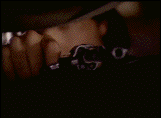 The single-action, army-type firearms were manufactured from 1873 to 1902. Colt
developed a New Army Model, but the open frame was weak. Soon after, they developed the Model P, entitled "the Peacemaker" (among other things), which had a new solid top frame. The gun was
strong and nearly impossible to wreck. It usually was a .45 calibre, and it could be loaded through a hinged gate let into the recoil shield on the right side of the frame behind the cylinder.
The spring-loaded ejector rod could be used to punch spent casings (or unfired rounds) backward and out through the gate. The Solid-Frame Army Colt barrel was typically 7 1/2 inches long.
The single-action, army-type firearms were manufactured from 1873 to 1902. Colt
developed a New Army Model, but the open frame was weak. Soon after, they developed the Model P, entitled "the Peacemaker" (among other things), which had a new solid top frame. The gun was
strong and nearly impossible to wreck. It usually was a .45 calibre, and it could be loaded through a hinged gate let into the recoil shield on the right side of the frame behind the cylinder.
The spring-loaded ejector rod could be used to punch spent casings (or unfired rounds) backward and out through the gate. The Solid-Frame Army Colt barrel was typically 7 1/2 inches long.
The single-action, commercial Colt Peacemakers were manufactured from 1873 to 1917. They had a combination of blued and case-hardened parts. The grips could be either walnut (standard), gutta-perch, ivory, or mother of pearl. The back sight was a groove milled longitudinally with the frame, and the length of the ejector-case barrels ranged from 4.75 to 16 inches long. Those barrels lacking ejectors ranged from 2 to 7.5 inches. A .44-40 chambering was popular, because the Winchester.44-40 cartridge could fit both the Colt and the Winchester Model 1873 lever-action rifle.
Read this very interesting articles about Texas Rangers and their use of Colts:
Colts of the Texas Rangers -- Colt Army 1860.
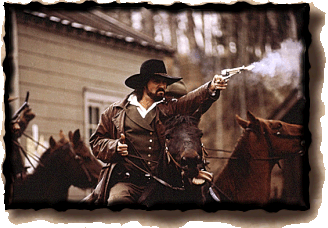
|
| Mosby fires an 1875 Remington. |
In 1863, the New Model Army Remington added safety notches between the nipples, and the attachment threads were visible where the barrel abutted to the cylinder face. These revolvers had brass trigger guards and were 13.8 inches long in overall length. The barrel was still 5-grooved, and it was also 8 inches long. It weighed about 46 ounces. The "New Model" or the octagonal barrel Remington was $13.30 versus $17.70 for the 1860 Army Colt. Interestingly, when Union calvary men were given the choice at the end of the Civil War to buy their service revolvers, more bought their Remingtons than their Colts. It was most likely due to the fact that army Remingtons had closed frames as opposed to the open frame of the army Colts during that same period.
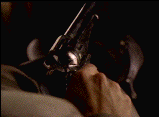 The Model 1875 Military Remingtons (also known as "The Outlaws") were made from
1875 to 1890. These revolvers were chambered for .44 Remington center-fire, the .44-40, or for the .45 Colt. The barrel length was 7 1/2 inches, and it different from the previous models in
that it was round. The revolver weighed about 44 ounces. It was blued or nickel-plated and had color case hardening on the hammer and loading gate. The standard grip was an oil-finished walnut,
but an ivory or mother-of-pearl grips could be ordered, as well. The Remington is known from the prominent web beneath the barrel. The military Remington had a lanyard ring on the butt. The
1875 Model did not sell well in the West, even though it was comparable. Between 1875 and 1889, only 25,000 guns were sold.
The Model 1875 Military Remingtons (also known as "The Outlaws") were made from
1875 to 1890. These revolvers were chambered for .44 Remington center-fire, the .44-40, or for the .45 Colt. The barrel length was 7 1/2 inches, and it different from the previous models in
that it was round. The revolver weighed about 44 ounces. It was blued or nickel-plated and had color case hardening on the hammer and loading gate. The standard grip was an oil-finished walnut,
but an ivory or mother-of-pearl grips could be ordered, as well. The Remington is known from the prominent web beneath the barrel. The military Remington had a lanyard ring on the butt. The
1875 Model did not sell well in the West, even though it was comparable. Between 1875 and 1889, only 25,000 guns were sold.
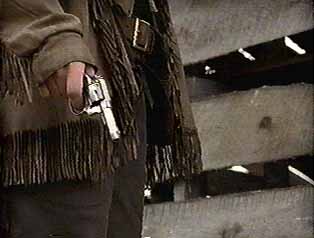
|
| Call gets ready to shoot his derringer, possibly a Webley "Bulldog" five-shot, .38 or .44. (thanks, Adam!) |
When other manufacturers decided to produce this small weapon, an extra "r" was added to disguise flagrant thievery. The term "derringer" applies to a small, short-barreled pocket pistol. Depending upon the manufacturer, derringers ranged in size from a large dueling pistol to a tiny concealable gun.
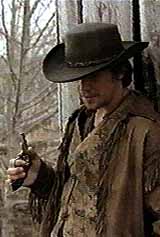 The derringers were popular for their ease of concealment. They were often used as a
hidden backup for gunmen. Many dance hall girls used them for defense in the bordellos. They also sold well among the gamblers.
The derringers were popular for their ease of concealment. They were often used as a
hidden backup for gunmen. Many dance hall girls used them for defense in the bordellos. They also sold well among the gamblers.
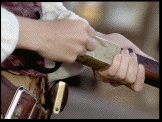
|
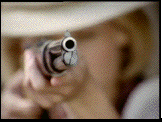
|
| Mattie loads and aims an 1866 Winchester rifle. | |
I focus mainly on Winchesters.
Soldiers on the plains carried single-shot Springfield carbines, and they fired a .50 calibre projectile. After 1873, the rifles were chambered for a .45-70 round.
Single-shot rifles, like the Sharps rifle, were manufactured for buffalo hunters. The "Big Fifty" could kill bison at ranges of 1,000 yards, especially when used with telescopes. The term "sharpshooter" is derived from the gun and from the excellency of the marksmen that cleared the plains of game.
The Peabody falling block and the Remington rolling block were also single-shot weapons used to clear the plains of big game. Nearly 3.7 million bison were killed alone in 1872 to 1874. The destruction of the buffalo also destroyed the Indians.
Repeating rifles were also developed during this time, and they were far more popular with the cowboys than with big game hunters or the military. The Henry repeating rifle was developed from the Jennings/Volcanic designs in 1860.
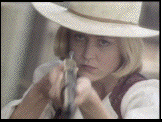 The lever action Winchester Model 1866 was nothing more than an improved
Henry. It had a hinged loading gate on the right side of the frame. This allowed the firer to insert cartridges virtually without taking his eyes off the target. The loading gate also permitted
a fixed magazine and a conventional wooden fore end to be used. The Winchester took a 28 grain powder weight. The reduction in the projectile weight from the single-shot rifles managed to
increase the projectile's velocity. The Model 1866 had a 24 inch round or octagonal barrel, weighing 9 to 9 1/2 lbs. The firearm could also be designed into an 8 1/4 lb. musket with a 27 inch
barrel. When designed as a carbine with a 24-inch round barrel, the rifle weighed 7 1/2 lbs. Rifles and muskets each held a maximum of 17 rounds, but they were usually loaded with fewer rounds
to prevent strain on the magazine spring. The carbines held a total of 13 rounds. The Model 1866 was manufactured until 1898.
The lever action Winchester Model 1866 was nothing more than an improved
Henry. It had a hinged loading gate on the right side of the frame. This allowed the firer to insert cartridges virtually without taking his eyes off the target. The loading gate also permitted
a fixed magazine and a conventional wooden fore end to be used. The Winchester took a 28 grain powder weight. The reduction in the projectile weight from the single-shot rifles managed to
increase the projectile's velocity. The Model 1866 had a 24 inch round or octagonal barrel, weighing 9 to 9 1/2 lbs. The firearm could also be designed into an 8 1/4 lb. musket with a 27 inch
barrel. When designed as a carbine with a 24-inch round barrel, the rifle weighed 7 1/2 lbs. Rifles and muskets each held a maximum of 17 rounds, but they were usually loaded with fewer rounds
to prevent strain on the magazine spring. The carbines held a total of 13 rounds. The Model 1866 was manufactured until 1898.
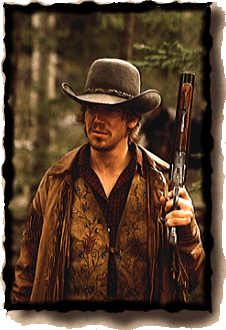
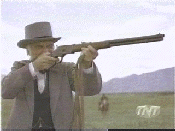
|
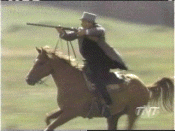
|
| The infamous Russian duke shot. Notice how he handles the rifle. | |
Apparently, there were some special guns and techniques developed specifically for this show. Look at the expert gun editing in these shots:
Back to Darcie's Lonesome Dove Page
Thanks, Linda and Gretchen, for the additional gun photos!